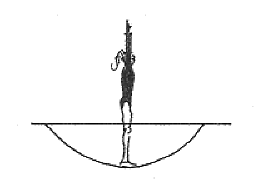Understanding landing (part two)
In my last article I drew attention to the technique of “landing” from a backward rotating skill and pointed out that practically every skill in a routine “lands” with a backward component. Even forward rotating skills are converted into backward finishes through the medium of half, one and a half, two and a half and three and a half twists. Readers who are familiar with my technical philosophy will understand why the word “landing” is in parenthesis end new readers are recommended to refer to GymCraft Issues No.1 (Feb/March 2003) and No.14 (April 2005) for clarification
Once it is appreciated that the gymnast, when coming in from a backward rotating skill, must make initial bed contact somewhat short in order to in arrive at foil depression as in Fig 1 below, we can turn our attention to the subsequent take off phase.

Fig 1
Whether the subsequent skill is forward or backward, the landing phase should be identical and the performer coached into disregarding the next take off until the preceding landing phase is complete. That of course is much easier said than done, because the gymnast has a very short time between initial contact and full depression in which to organise that transition. This requires a very high degree of technical and mental sharpness but then that is what world class trampolining is all about!
I frequently hear coaches imploring their performers to “slow it down” “wait for the bed” “don’t snatch the take off” “stand up into the take off” and whilst all are sound pieces of advice they are unlikely to produce the desired outcome on a consistent basis. The most effective way is for the coach to make sure the performer understands the process in detail and to rehearse the sequence using simple skills which the gymnast perceives to be low risk. For example if one wanted to improve the start of a routine which begins with half out/double back and those two skills are at the top end of the current repertoire, it is highly unlikely that the performer would be able to make significant changes within that combination itself. The first requirement is to make sure that the gymnast understands the technique required and is given related practices which are much less intimidating e.g. tucked barimi/tucked back. Clearly if the requirement was to improve double back/half out, an appropriate simulation would be tucked back/tucked front.
The issue I have just raised is at the core of all trampoline coaching. Namely bridging the gap between the performer understanding what is required when listening to the coach and being able to reproduce that understanding in movement terms when they are about to touch down on the trampoline ready to carry out the coach’s advice. It is at this point that their intellectual capabilities are over ridden by the instinct of self preservation resulting in a reversion to familiar, comfortable, but incorrect actions. So we must work on these techniques in a comfortable environment either by down grading the combination or using the landing mat to enable intellect to overcome fear.
Having made that brief digression let me return to my main theme. The trampolinist has touched down slightly short and dropped into the “hole.” They are now standing tall with the bed at full depression. No movement has taken place to initiate the next skill and indeed none is required at this point. It is here that the majority of mistakes are made when attempting to link skills together. If the next skill is to rotate forwards the classic error is to displace the hips backwards as shown in Fig 2 thereby inhibiting the upward force from the bed, (effectively “killing the bed”) This will certainly result in a serious loss of height and probably an undesirable element of gain.

Fig 2
If the skill is intended to rotate backwards there are two classic errors possible. Firstly the hips may be driven forward in a mistaken belief that a powerful backward somersault will result (Fig 3) or the shoulders will be thrown back in the same belief (Fig 4).

Fig 3

Fig 4
Both these errors will lead to loss of height with Fig 3 showing clearly that gain is also a probability and Fig 4 illustrating that travel is an inevitable outcome. So those are the mistakes, but what should the performers actually be doing to create a skill with sufficient rotation and no loss of height? i.e. to achieve “top.” (GymCraft Issue No 8 April 2004, Issue No 9 June 2004 and Issue No 10 Aug 2004).
If a forward skill is required the gymnast must wait in the standing position with the arms overhead, resisting the temptation to initiate rotation until the bed starts to recoil. This will harness the power of the bed and springs ensuring that the resulting somersault has sufficient height. As this force starts to take effect the gymnast can begin to redirect it through hip displacement and foot pressure to create the rotation required. It takes surprisingly little hip displacement to produce a double rotation if the performer has first tapped into the power of the recoiling bed and springs. This is a far cry from the traditional view of powerful hip displacement to produce fast rotation and the trampolinist can be directed to simply “suck in your guts!” Compare Fig 5 with the shape and timing illustrated in Fig 2.

Fig 5
If backward rotation is required, once again the performer must resist the temptation to “make” it happen through a powerful hip displacement but rather “let” it happen as a result of allowing the residual rotation from the incoming skill to take effect. All that is needed once the vertical force has been harnessed is a lift of the chest. The more subtle this action, the higher and slower will be the somersault. The performer must understand that a high slow somersault is not necessarily too slow because height brings with it the benefit of increased time for the rotation to take effect and enables tighter shaping to facilitate a faster spin. It takes a surprisingly small amount of torque to produce a double back somersault if the performer first harnesses the vertical force from the bed recoil. Compare Fig 6 with the shapes and timing shown in Figs 3 & 4.

Fig 6
I hope I have managed to put a bit of flesh on the bones of those popular coaching points “Slow it down” — “Wait for the bed” — “Don’t snatch the take off” — “Stand up into the take off.” I hope too that coaches will take the trouble to encourage their trampolinists to understand the process in detail as they strive for excellence.
© Jack Kelly
 ®
®













